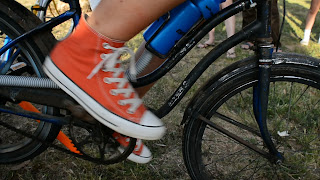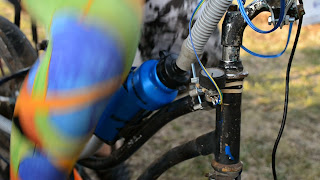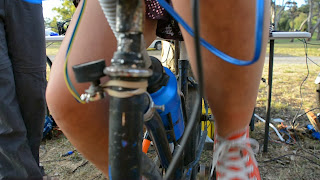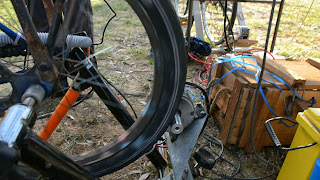As I brace myself for the onslaught of the Falls Festival in Lorne, Here's a hastily slapped down breakdown of the bike powered computer game concept we launched at the Nati Frinj. There were 3 games made but they all hinged around the use of an arduino to forward a bunch of information capture off the bike via a range of sensors into Unity which generated the visuals in response. The Oculus Rift was a late but excellent addition to the setup. I had originally intended to build a little head sized projection booth so that only cyclist could see.
Compared to this though, a pair of goggles that responds to the orientation of the riders head and provides the visuals in 3D just takes it a step beyond the original concept. When we were building this rig the plan was that the entire power for the game be generated by the cyclist and the power consumtiption of the goggles beat out any comparable projection system (without even factoring n th nightmare of me trying to sculpt up a firbeglass projection dome). I must be the only person ever to have bought an Oculus Rift for its relatively low power consumption.
There is a video of the whole Art Pumping action thing (with the actual Virtual Reality part starting at about 1 minute).
Art Pumping Action Compilation from dave jones on Vimeo.
The
3 bikes were placed radiating out from the central table so that we could get away with one of the riders throwing themselves off the bike without setting off a domino effect.
So all the goodies, arduino etc are packaged up in the blue water bottle container there (genius idea courtesy of Callum)
The light mounted on the front of the bike and powered by the generator on the back wheel provided the load. By turning up and down the brightness of the light up and down then makes more work for the rider.
A hall effect sensor on the back wheel measures how fast the wheel is turning and sets the speed of the bike in the game.
The dial rubbing against the front steering fork (scavenged off an old oven) is stuck to a potentiometer and feeing back the steering info.
In the background, the screen is displaying the riders eye view. I hadn't intended to leave this here for the duration but it was such a crowd pleaser that I left it there the whole festival. It was great actually when the people queuing up to have a go were cheering on the rider.In this particular game the goal was to round up sheep and flick them into the trailer you are towing (by running them down). The game was conceived by one of the students during a workshop at the local primary school.
In the background you can see the Regulator and battery setup courtesy of Greer Allen of Magnificent Revolution. Does a great job of capturing an storing all the spare power generated by the bike. The Bike is more than capable of generating the power to run the laptop (35watts) and oculus (5 watts + maybe some coming out of the computer USB???)
The bike when it was going hard was able to put out about 100 watts
The more electricity the bikes had to produce the hard it was to spin the generator.
This was hooked up to the gradient of the hills the rider had to climb in the game. The steeper the hill the brighter the light, the harder it was to pedal. The result was surprisingly convincing.
Just for good measure I wired up a bunch of bells and horns at the front that could be used to jump, fire or whatever. I didn't end up taking as much advantage of these as I thought I might have...the main reason being the oversight that when you've got the Oculus goggles on its actually pretty hard to find the bells.
Heading off in the morning to go down and install these beauties at the Falls Festival in Lorne over new years and, quite frankly, a little daunted about how they might hold up to the onslaught of 16,000 adrenaline-fueled youths over new years.
Perhaps this shall be my last post....


















































